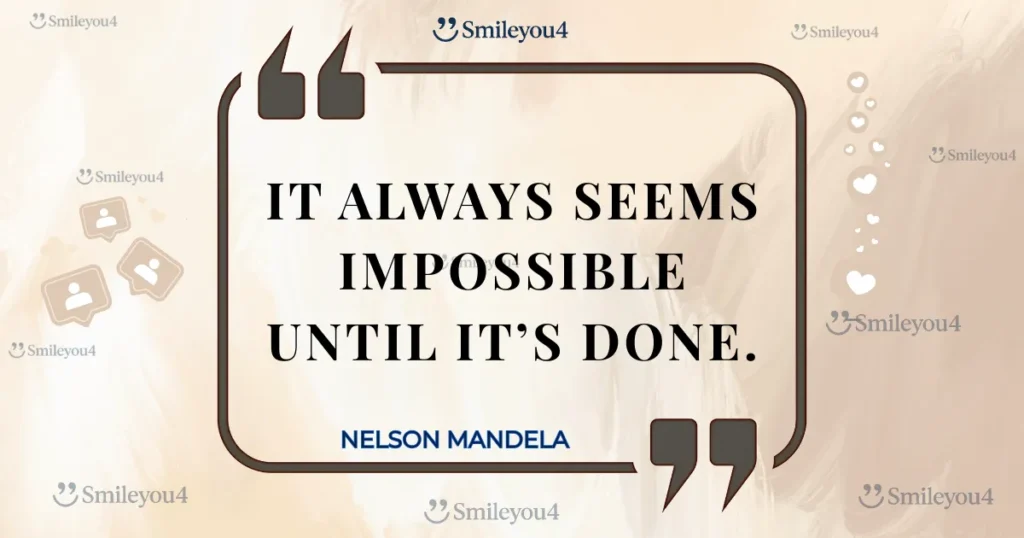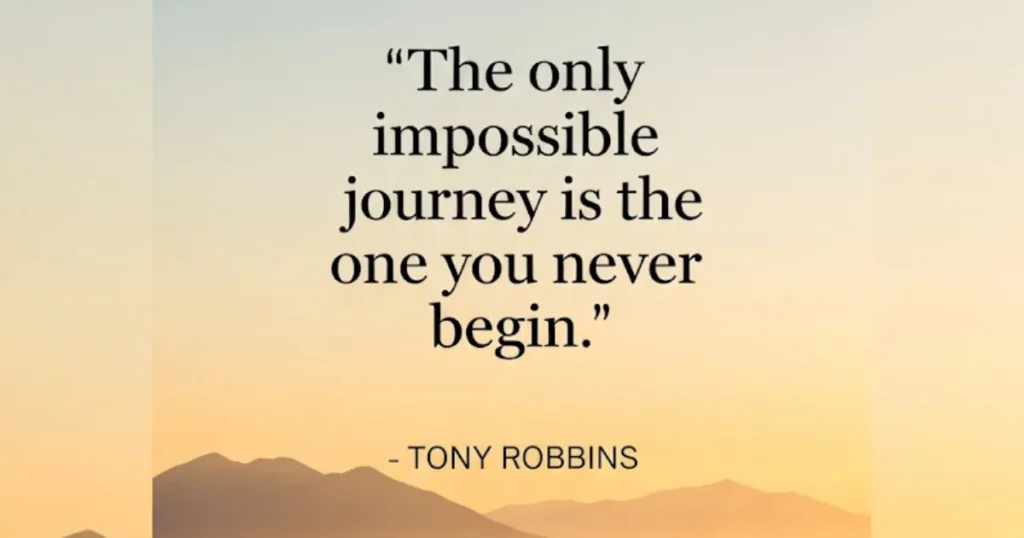What if the thing you believe is impossible right now is actually your next breakthrough waiting to happen? Nelson Mandela knew this truth intimately when he said, “It always seems impossible until it’s done.” This impossible until it’s done Nelson Mandela wisdom didn’t come from a motivational speaker—it came from a man who transformed an entire nation against all odds.

You’ve probably felt that crushing weight of impossibility before. Maybe it’s starting your own business, losing that extra weight, or healing a broken relationship. The mountain feels too high, the gap too wide, the challenge too overwhelming. But here’s what Mandela understood: impossible until it’s done isn’t just about changing your circumstances—it’s about changing how you see what’s possible.
Today, we’ll explore how this powerful mindset can transform your approach to any challenge. You’ll discover why your “impossible” dreams might be closer than you think and learn practical steps to turn today’s impossibilities into tomorrow’s victories.
The Man Who Made the Impossible Possible
Nelson Mandela’s Journey from Prison to Presidency
When Nelson Mandela spoke about things being impossible until it’s done, he wasn’t offering empty motivation. He lived this truth through 27 years of imprisonment, watching apartheid seem more entrenched than ever, yet never losing sight of his vision for a free South Africa.
The odds against Mandela were staggering. He faced a racist government with unlimited power, international indifference, and decades of systematic oppression. Most people would have called his dream of a democratic South Africa completely impossible. Yet this Nelson Mandela impossible until it’s done philosophy sustained him through nearly three decades of struggle.
What made Mandela’s approach different was his understanding that impossibility is often just a matter of timing and persistence. He recognized that what seems impossible today becomes inevitable when you combine unwavering vision with consistent action over time.
The Psychology Behind the Quote
“It always seems impossible until it’s done.” Let’s break down why this Nelson Mandela insight is so powerful:
- “It always seems” acknowledges that impossibility is often perception, not reality
- “Impossible” represents our mental barriers and limiting beliefs
- “Until it’s done” suggests that completion changes everything we thought we knew
- “It’s done” implies that impossible things become possible through action
This impossible until it’s done wisdom works because it reframes our relationship with difficulty. Instead of seeing obstacles as proof something can’t be done, we begin viewing them as temporary barriers waiting to be overcome.
The Science of Turning Impossible into Possible
How Your Brain Processes “Impossible”
Modern neuroscience reveals why the impossible until it’s done Nelson Mandela philosophy is so effective. When you label something as impossible, your brain literally stops looking for solutions. Your reticular activating system—the part of your brain that filters information—begins highlighting evidence that supports your belief while ignoring possibilities.
However, when you shift from “this is impossible” to “this seems impossible right now,” you activate different neural pathways:
- Problem-solving networks become more active
- Creative thinking increases significantly
- Pattern recognition improves for finding opportunities
- Motivation centers receive more stimulation
This explains why Nelson Mandela could maintain hope during 27 years of imprisonment. His brain remained open to possibilities that others couldn’t see.
The Power of Progressive Achievement
Research shows that what seems impossible until it’s done often involves a series of smaller possible steps. Psychologists call this “chunking”—breaking overwhelming goals into manageable pieces that don’t trigger your brain’s impossibility response.
When you apply this to any challenge:
- Large impossible goals become series of smaller difficult tasks
- Each completed step builds confidence for the next
- What seemed impossible yesterday feels challenging but doable today
- Success creates momentum that makes future “impossible” things easier
Real-Life Examples of Impossible Until It’s Done
The Wright Brothers: Defying Gravity and Skeptics
In 1903, human flight was considered scientifically impossible. Experts had “proven” that humans were too heavy to fly. Yet Orville and Wright persisted, embodying the impossible until it’s done mindset that would change transportation forever.
Their approach demonstrates key principles:
- They studied the problem systematically rather than accepting expert opinions
- They built on small successes, improving with each experiment
- They maintained vision despite repeated failures and public mockery
- They focused on solving specific problems rather than the overwhelming goal of “flight”
When their plane finally lifted off at Kitty Hawk, the impossible until it’s done Nelson Mandela principle played out perfectly. Suddenly, human flight wasn’t impossible—it was inevitable.
Oprah Winfrey: From Poverty to Media Empire
Born into poverty and facing abuse, discrimination, and countless setbacks, Oprah’s rise to becoming one of the world’s most influential media personalities seemed impossible. Yet her story perfectly illustrates how impossible until it’s done becomes reality through persistent action.
Oprah’s transformation involved:
- Refusing to let circumstances define her possibilities
- Using each setback as fuel for greater determination
- Building skills one opportunity at a time
- Maintaining belief in her vision when others couldn’t see it
Today, what once seemed impossible—a poor black girl from Mississippi becoming a billionaire media mogul—is simply Oprah’s completed story.
Steve Jobs: Revolutionizing Multiple Industries
When Steve Jobs envisioned putting “a computer in every home,” experts called it impossible. Personal computers were seen as toys for hobbyists, not necessities for families. Yet Jobs embodied the Nelson Mandela impossible until it’s done philosophy, transforming not just computing, but music, phones, and tablets too.
His approach reveals important patterns:
- He questioned assumptions that others accepted as unchangeable
- He focused on user experience rather than technical limitations
- He persisted through failures, firings, and industry skepticism
- He maintained vision while adapting tactics based on what he learned
The result? Multiple industries transformed by someone who refused to accept “impossible” as final.
Practical Strategies to Apply “Impossible Until It’s Done”
Step 1: Reframe Your Impossible Challenge
Before you can make progress on something that seems impossible until it’s done, you need to shift your language and thinking. Most people sabotage themselves by how they frame challenges.
Instead of: “This is impossible”
Try: “This seems impossible with my current approach”
Instead of: “I could never do that”
Try: “I haven’t learned how to do that yet”
Instead of: “It’s too late to start”
Try: “The best time to start is now”
This reframing activates the Nelson Mandela mindset that kept him hopeful during decades of struggle.
Step 2: Find Your “Impossible” Examples
Look for evidence that your specific challenge has been overcome before. The impossible until it’s done Nelson Mandela principle works better when you see concrete examples of others who’ve succeeded where you want to succeed.
Research people who have:
- Started businesses in your industry from scratch
- Overcome health challenges similar to yours
- Built relationships after difficult divorces or losses
- Learned new skills at your age or stage of life
- Transformed their careers in ways you’re considering
Each example proves that your “impossible” challenge is actually just difficult.
Step 3: Break Down the Impossible
The impossible until it’s done approach requires breaking overwhelming goals into manageable steps. Mandela didn’t wake up one day and end apartheid—he took consistent action over decades.
Use this framework:
- Define your impossible goal clearly
- Identify the major milestones that would mark progress
- Break each milestone into monthly objectives
- Divide monthly objectives into weekly actions
- Create daily habits that support weekly actions
This systematic approach transforms “impossible” into a series of challenging but doable tasks.
Step 4: Build Your Impossibility-Crushing Toolkit
Develop specific strategies for when things feel impossible until it’s done:
For motivation challenges:
- Keep a collection of stories about people who overcame similar obstacles
- Create a vision board showing your goal already achieved
- Write yourself a letter from your future self who has succeeded
- Find accountability partners who believe in your “impossible” dream
For skill development:
- Identify the top three skills you need and focus on one at a time
- Find mentors who’ve mastered what you’re trying to learn
- Practice consistently rather than perfectly
- Celebrate small improvements to build momentum
For persistence:
- Track your progress visually to see how far you’ve come
- Prepare responses for when others call your goal impossible
- Create systems that keep you moving forward on difficult days
- Remember that Nelson Mandela maintained hope for 27 years
Overcoming Common Obstacles to “Impossible” Goals
Dealing with Skeptics and Naysayers
When you pursue something that embodies impossible until it’s done, you’ll face people who try to “protect” you by pointing out all the reasons you’ll fail. Handle this by:
Understanding their motivation: Most skeptics fear disappointment more than they fear your success. They’re often projecting their own limitations onto your situation.
Choosing your audience: Share your big dreams only with people who have either achieved similar goals or consistently support your growth.
Using doubt as fuel: Let skepticism motivate you to prove that impossible until it’s done Nelson Mandela wisdom applies to your situation too.
Managing Your Own Inner Critic
Your biggest opponent in making impossible until it’s done a reality is often your own mind. Combat self-doubt by:
- Keeping a daily journal of small wins and progress
- Studying biographies of people who achieved “impossible” things
- Practicing self-compassion when setbacks occur
- Reminding yourself that everyone who succeeded felt uncertain at times
Staying Motivated During the Long Journey
The Nelson Mandela approach requires sustaining motivation over extended periods. Build systems that support long-term persistence:
Create milestone celebrations: Plan specific rewards for reaching major progress points, not just the final goal.
Find your deeper why: Connect your “impossible” goal to values and purposes that matter more than comfort or convenience.
Build a support community: Surround yourself with people who are also pursuing challenging goals.
Document your journey: Keep records of your progress so you can see how far you’ve come on difficult days.
Your Impossible Dream is Waiting
Nelson Mandela’s insight that things are impossible until it’s done isn’t just historical inspiration—it’s your blueprint for transforming any area of your life. The dream that feels too big, too late


